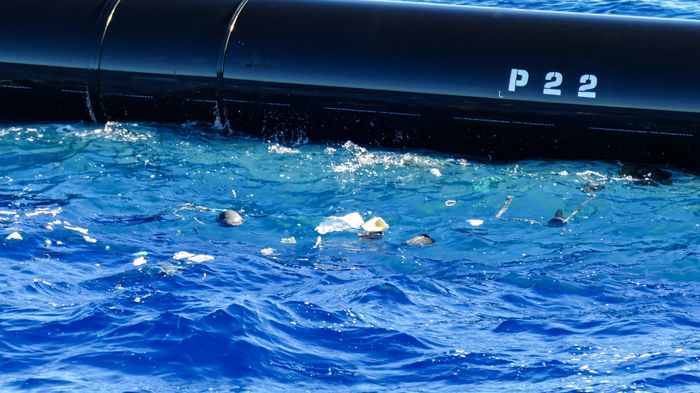
The Ocean Cleanup and the Neuston
Back to updatesOn January 22, an opinion piece was published in The Atlantic, originally titled “The Ocean Cleanup Project Could Destroy the Neuston.” Since preventing the destruction of ocean ecosystems is the main purpose of the cleanup effort, any potentially significant environmental side-effect is taken very seriously by our team. This post will hopefully shed more light on the neuston and how our system could potentially interact with these organisms.
At The Ocean Cleanup we are on a mission to rid the world’s oceans of plastic. We made this our mission because we believe that the health of our oceans is essential for all life on Earth to prosper. According to the World Economic Forum, with the current trajectory, plastic could outweigh fish in the oceans by 2050. To us, that future is unacceptable.
Our first focus is to clean up the so-called ocean garbage patches; of the world’s ocean surface, these are the five areas where plastic accumulates. This means that, even if no more plastic enters the oceans, the plastic trapped in the currents of these accumulation zones will continue to cause harm, as it chokes or entangles countless marine mammals, sea turtles, fish and all other marine life, for decades and possibly even centuries to come. On top of this, ocean plastic carries toxic chemicals, which get carried through the food chain, ultimately making their way into the human diet. This is why we must clean up these ocean garbage patches.
Of course, this mission will not be easy. Designing a cleanup system that can last many years in one of the most challenging environments on this planet, while safely and efficiently collecting plastic, is a grand engineering challenge.
The trickiest part, as is inherent to innovation of this caliber, is that many of the essential aspects of our technology must be tested in real life conditions (i.e. in the ocean). Scale model testing or computer simulations will only teach us so much. Therefore, we follow an iterative development path, through which we learn by doing; that includes the testing of our first full-scale cleanup system, which is currently under revision for upgrades, ahead of re-launch.
It is also the reason why we actively welcome and appreciate feedback. With a mission of such complexity, we can use all the help we can get.
After learning of The Atlantic piece, we took this as a potential opportunity to incorporate more feedback. The central thesis to the claims made in the column can be summarized as follows:
- The Environmental Impact Assessment (EIA) produced for The Ocean Cleanup didn’t consider the neuston community.
- Cleaning up 90% of plastic from the ocean will kill 90% of the oceanic neuston, which will devastate this ecosystem.
- This is especially worrying as we don’t have a solid understanding of this ecosystem yet.
Before we delve into this feedback, it might be helpful to provide some background on Environmental Impact Assessments and the neuston.
WHAT IS AN ENVIRONMENTAL IMPACT ASSESSMENT?
An EIA is a decision support tool, providing information on the likelihood of an impact on the local environment in connection to a specific project or activity. Its purpose is to determine the potential environmental, social, and health-related effects (if applicable) of a project so that those who develop and authorize the project can be informed in their decision-making, while it also indicates how these potential impacts can be reduced or mitigated.
Because of the novelty of the cleanup system and the international location of its deployment, The Ocean Cleanup was not legally required to conduct an EIA for System 001. However, as we always want to move forward in our cleanup operation transparently and with the best available knowledge, we chose to voluntarily initiate one.
You can read more about our EIA from our update in July after we had received the conclusions from the independent agency who conducted the assessment.
WHAT IS THE NEUSTON?
Neuston is a term used to describe the organisms that spend a fraction or the entirety of their life on the water surface (epineuston) or right under it (hyponeuston). There is some debate on how to accurately define the group, but for the sake of consistency, we refer to the phrasing from The Atlantic column: “Organisms that live exclusively by floating at the surface of the water are called pleuston, while neuston is a broader term, referring generally to the sea-surface ecosystem”.
One of the most common species of the neuston community is Velella velella, an organism which consists of a colony of polyps that lives throughout the world’s oceans. You may be familiar with them as they frequently strand on beaches across the world.

Welcoming feedback
The EIA was produced by a group of independent scientists and is the result of a comprehensive analysis of available scientific literature. However, we realize that scientists are humans too, and that there can always be room for improvement. This is why, when the EIA was released on our website, we also opened up the email address EIA@theoceancleanup.com, specifically with the purpose of enabling the wider public – and scientific community – to provide feedback on the EIA to its authors.
Before The Atlantic column was published, we had been in contact with the author of the piece, Dr. Rebecca Helm, following a series of her tweets, in which she expressed her concerns about the impact that our system would have on the neuston community. We proactively reached out via email, inviting her to send a more detailed view of her concerns and some supporting evidence, thus opening the door for a scientific discussion on this topic between peers.
After initial contact was made, a few emails between Dr. Helm and the authors of the EIA were exchanged in the second week of January, during which she shared three peer-reviewed articles with general information on neuston. One article was from 1956 and written in Russian; unfortunately, a translation was unavailable (but we are working on it). The other articles, both written in English, were from 1962 and ‘74. These papers referenced a few species within the neuston community that were not mentioned in the EIA, including Janthina, Glaucus and Minyas.
However, these papers did not provide any quantitative data of these neuston. This type of information is required for use in an EIA to determine to what degree a project affects certain species; therefore, the articles could not be used to improve the EIA prepared for System 001.
DID THE ENVIRONMENTAL IMPACT ASSESSMENT OMIT THE NEUSTON?
The Atlantic piece contains claims that the neuston was omitted from the EIA. However, this is incorrect; species that are part of the neuston ecosystem in the North Pacific have been considered in the EIA, in section 4.3.1.2: Gelatinous Macrozooplankton. In Table 4-2 of this section, all species that have previously been observed near the deployment site of our cleanup system are referenced, including by-the-wind sailors (Vellela vellela), blue buttons (Porpita porpita) and the Pacific Portuguese man o’ wars (Physalia utriculus).
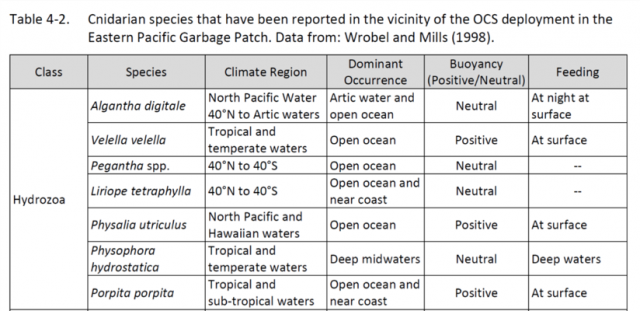
COULD A CLEANUP OPERATION DESTROY THE NEUSTON?
There are strong assertions in The Atlantic column, such as “the project could rob the world of an entire ecosystem that we don’t understand and may never get back” and that, because of our work to rid the oceans of plastic, all of the neuston are “in peril”. These claims are based on the belief that “cleaning up 90 percent of the plastic using the current cleanup method means potentially destroying 90 percent of the neuston” and that “neuston and plastic co-occur: They’re in the exact same spots.”
If there is any evidence that would substantiate this level of impact, we invite it to be shared with us. That being said, neither the literature review conducted for the EIA nor the additional articles that were provided to us contained any data in support of these statements.
For what we know, most of the species that comprise the neuston are ubiquitous and distributed throughout the tropical and temperate zones of all the world’s oceans, an area that measures more than 300,000,000 km2 about 30x the size of the USA.
Despite this understanding, a drawn map from a 1968 study is referenced in the piece, showing the neuston subdivided into seven distinct zones in the Pacific Ocean, spanning from Alaska all the way to New Zealand; one of which is depicted as directly overlapping with the area where the plastic accumulates in the North Pacific Ocean.
Aside from the fact that the validity of using a single, 51-year-old source could be questioned, it might be important to note that the author himself states on page 414 of the article that “it can be considered only as a preliminary chart”.
But assuming this map provides an accurate view of distinct neuston ecosystems, the surface area identified as “Neuston ecosystem 2” measures about 50 million km2, while the Great Pacific Garbage Patch is ‘only’ 1.6 million km2 or 3% of the entire neuston ecosystem 2. The deployment area of our cleanup operations will likely be limited to the area of highest concentration, which measures less than 500.000 km2 – 1% of this zone’s size.
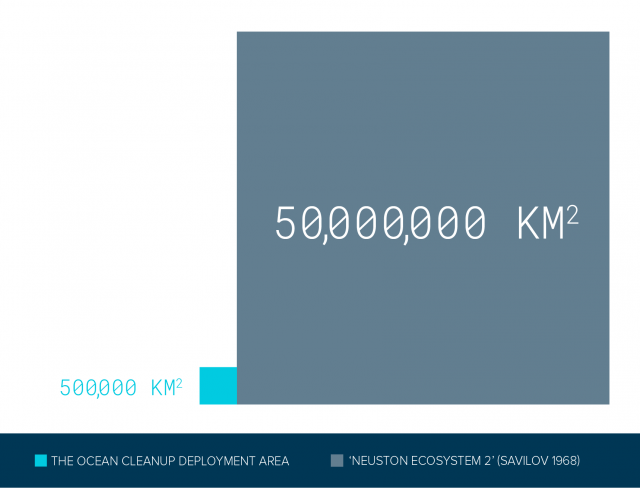
Considering the Great Pacific Garbage Patch covers only a small percentage of one of these seven zones, it is clear that neuston and plastic are not equally distributed.
Still, we continued to seek validation for these statements using the shared literature, but, rather than confirmation, we found further support for the opposite. An excerpt from one of the provided articles reads:
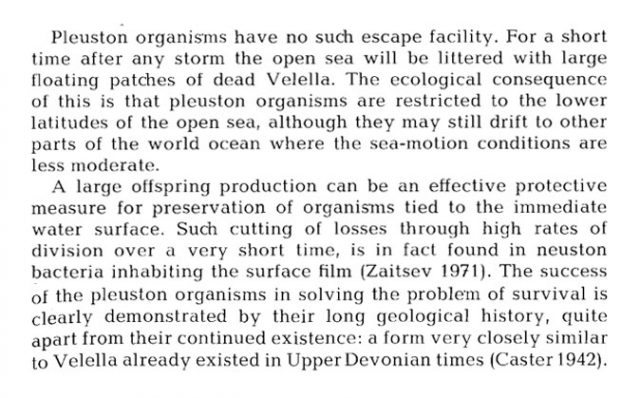
In other words, some species within the neuston have developed survival strategies, such as a high reproduction rate, to adapt to losses. Whereas, plastic, on the other hand, does not reproduce; the plastic removed from the patch, will not return to the patch. This undermines the idea that a 90% removal of plastic equates to a similar reduction in the neuston.
Professor Gerhard J. Herndl of the Vienna University, whose research group has studied the neuston in the North Atlantic Gyre, an ecosystem very similar to the Great Pacific Garbage Patch, confirmed the following:
“Most plankton and neuston organisms are adapted to high loss rates as they are washed ashore with every wave hitting the shores. Open ocean neuston are less subjected to be washed ashore but there are other stressors such as high turbulence fragmenting these fragile organisms during storm events. Compared to these stressors, the loss of neuston organisms occurring if they are trapped by The Ocean Cleanup’s system is extremely small considering the area covered by the cleanup and the dimensions of the North Pacific gyre. The recruitment of these neuston organisms will definitely compensate by far these losses.”
FURTHERING THE UNDERSTANDING OF THE ECOSYSTEM
The Atlantic column states that “the fact that we don’t have a solid understanding of the neuston ecosystem is even more worrying: we will have very little “before” data to compare The Ocean Cleanup’s impact against”. The scientific understanding of the abundance and population dynamics of neuston species is, in some cases, indeed limited and that this inherently causes uncertainty. However, this is exactly the basis on which our testing and monitoring strategy is built. Rather than deploying the whole fleet of cleanup systems at once, we started with just one system, which not only allows us to optimize the technology before scaling up, but also gives us the opportunity to study the interaction between the system and the local environment.
Beyond the EIA, the agency that conducted the EIA developed an Environmental Management Plan (EMP) which is used during our offshore operations. The EMP is a guideline for monitoring and mitigating any potential impact on the environment around System 001. And in addition to the EMP, for the four months of System 001’s maiden voyage, we have had an on-site monitoring vessel on a near-permanent basis, and one of its main tasks has been to conduct environmental observations. Monitoring the system is fundamental to our testing plan, as it allows us to verify the safety of the cleanup technology, while increasing the available general knowledge of the ecology of the Great Pacific Garbage Patch.
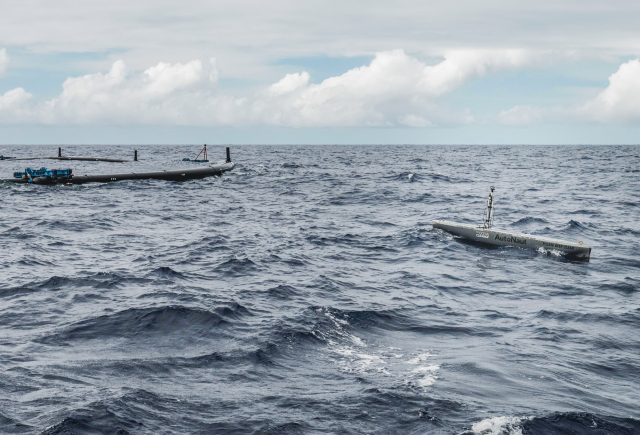
In the 115 days of operation, our marine biologists and independent environmental observers onboard the monitoring vessels have conducted 737+ hours of observational surveys for protected species and marine life in general – including neuston – surrounding the system. More than 150 low-altitude flights with drones equipped with live streaming cameras were performed. There were also 56 inspections with a support vessel and 49 days of remote vessel data collection carried out during this time.
Rather than a threat, The Ocean Cleanup’s project is providing an unprecedented opportunity to collect data and further the understanding of the Eastern North Pacific Ocean, including the neuston ecosystem. We look forward to sharing these observations and data with the wider scientific community.
CONCLUSION
We would like to thank Dr. Rebecca Helm for taking the time to share her concerns and for accepting a dialogue with us. The health of the oceans is clearly a matter that all of us care about and want to collectively solve.
However, based on the available data, we have not found any evidence that supports the idea that the neuston are at risk because of our efforts in developing technology that can rid the oceans of plastic.
Should you have access to any sources that suggest any negative environmental impacts of our system that we have not considered, or if you have any other concerns on the EIA, please share them with us through EIA@theoceancleanup.com.
On the other hand, zooming out to the bigger picture, there is strong evidence that the hundreds of thousands of tons of toxic plastic that is floating in the ocean is damaging ecosystems, which, ironically, may include the neuston.
The threat of extinction is real, and that is for the 117 endangered species that are currently being harmed by plastic pollution in the oceans. A cleanup, done responsibly, can help change that.


